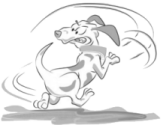|
|
Dog Tail Movement Meaning & Problems |
|
-
Relaxed tail: Relaxation
and comfort.
- Hanging horizontal but not
stiff: A sign of attention. The dog sees something
interesting.
- Hanging horizontal but stiff: The
dog is confronting an intruder or someone or something unknown.
- Upright tail: This is a
sign of authority of a dog that shows itself dominant.
- Upright tail and turned over
the back: Shows trust and self-control.
- Downward and close to the hind
legs: If its extremities are rigid and it wags its tail
slightly, it shows "I'm not feeling well". If its legs
are slightly bent it's a sign on insecurity.
- Tail hidden between its legs: Fear
or submission.
- Raised tail and slow and
rhythmic movement: The dog is on guard.
- Wagging lightly: Is their
normal welcome.
- Wagging with broad circles: "I
like you". When two dogs are mock fighting this movement
confirms it's a game.
-
Wagging at a slow speed: When
it's being trained it means "I'm trying to understand you,
I want to know what you're saying but I don't understand
yet". Once it finally understands, the dog wags its tail
faster.
- Short and slow movements: Shows
that it's pleased. Sometimes its only wags its tail a few times
when it's on the floor.
- Wagging fast: Excitement to
a desired activity or object.
|
|
|

|
|
Most Common Tail Injuries |
|
|
|

|
|
Bleeding Tail Tips |
|
Bleeding from the end of the tail is a common problem which can be difficult to cure
The tail is well supplied with blood, and if the end of the tail gets injured, or if the skin dries and cracks it can bleed profusely. As they get older Giant breeds of dog such as the Irish Wolfhound seem to get dry, cracked skin at the end of the tail which periodically bleeds. What is worse, dogs that wag their tail knock their tail tip on walls, furniture and other objects and this keeps opening up the wound. Various techniques can be used to protect the tail tip from this repeated injury including :
-
A tail bandage . These are difficult to apply properly and should only be put on by a veterinarian or experienced veterinary nurse. If they are put on incorrectly they act as a pendulum weight and slide off during tail wagging. If they are put on too tight they can cut off blood supply to the end of the tail. Being soft, bandages do not totally stop injury during tail wagging.
-
A hard protective cover (eg a plastic tube) can be strapped into place over the end of the tail tip to protect it. Again, this should be done by a veterinarian or veterinary nurse.
Sometimes a dog resents the presence of a bandage or plastic cover and will bite it causing more damage to themselves in the process so sedation may be needed, or an
Elizabethan Collar can be worn to prevent self-trauma to the tail tip or cover.
Applying cream, emulsion, emollients or lotions to soften the skin sometimes helps with cracked skin - your veterinarian will advise on the most appropriate product,
If infection is present your veterinarian will prescribe an antibiotic.
In the worst cases the wound simply will not heal properly and amputation of the tail tip is needed. Unfortunately, this can be frustrating to manage afterwards because the tail tip has to be protected during healing of the surgical wound, otherwise the whole cycle of injury, bleeding, and repeat injury occurs again.
ProVet
Web Site
|
|

|
|
|
|
How to fix a broken tail?
Some dogs are known for exuberant tail wagging which can cause breaks. Here is some advice from years of Greyhound tail breaks. Assuming the tail is still in basically a straight line, and the broken end is not at an odd angle to the rest of the tail ... AND assuming that there wasn't a lot of crushing pressure on the tail that has seriously affected the blood supply, then ...
-
Take either a pencil or a chopstick and some appropriate bandaging tape.
-
Lay the chopstick/pencil so that it extends about 3 inches past the break in both directions.
-
Tape the tail to the chopstick.
If the dog is a chewer or licker, spray the bandage with antichewing spray. I personally find the ones designed for horses, to make them stop cribbing are more effective than the ones designed for dogs.
That's it. No big splint, no cast. The bigger the splint/cast, the more adversely it affects the blood supply, and the more it will make the dog feel that something weird is on its tail that it needs to get off.
Dogs do not seem to have a lot of sensation in their tails under normal conditions, so a broken bone in a tail isn't as sensitive as a break in a toe.
Breaks can be SO painless that the owner doesn't even notice that the tail is broken until it heals slightly
crooked. If a tail gets crushed, like in a car door, or skinned in some unfortunate accident, then yes, I would expect that to be painful and considerably more difficult to heal. |
|
|

|
|
Tips |
-
For split tails, applying FLINTS MEDICATED OIL
(from the produce store) several times daily (as often as possible) will work wonders! Within a week you should see hair regrowth and the split healed.
-
A hollow centre hair roller can be taped on over the end of the tail
for protection.
|
|

|
| LINKS TO ARTICLES ON OTHER SITES |
|
|
|
|
 |
| |

|
|
|